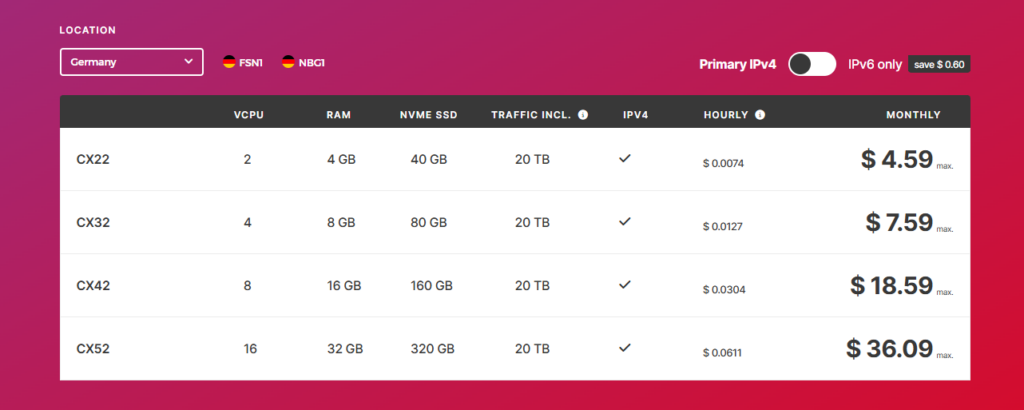You’re ready to launch a website, host a game server, or run a side project.
You’ve heard Hetzner’s VPS is dirt cheap and reliable.
But the process feels like a maze—where do you start?
What if you pick the wrong plan or mess up the setup?
I’m here to cut through the noise.
This guide walks you through buying a VPS from Hetzner, step by step.
Plus, I’ll drop pro tips to save you time, money, and headaches.
Why Truehost Deserves a Shoutout for VPS Hosting
Before we look at Hetzner, let’s talk about another player crushing it.
Truehost offers some of the cheapest, most reliable VPS plans out there.
Their servers are blazing fast, and their support team doesn’t leave you hanging.
Why mention Truehost in a Hetzner guide?
Because I want you to know your options.
Hetzner’s great for budget-conscious folks who don’t mind a bit of DIY.
But if you want a smoother ride with killer support, Truehost is worth a look.
Check them out after this guide to compare—they might just steal the show.
Why Choose Hetzner for Your VPS?

Hetzner’s a German hosting giant with a cult following.
Why?
They deliver high-performance VPS at prices that make you double-take.
Think $4/month for a solid starter plan.
Their data centers in Germany, Finland, USA, and Singapore scream reliability.
But it’s not all sunshine.
The signup process can feel like a tax audit if you’re not prepared.
And you’ll need some tech chops to manage your server.
Still, for developers, small businesses, or hobbyists, Hetzner’s a no-brainer.
Step-by-Step Guide to Buying a VPS from Hetzner
Let’s break this down into bite-sized steps. Follow along, and you’ll have your VPS up in no time.
Step 1: Create a Hetzner Account
Head to Hetzner’s website.
Click “Sign Up” at the top.
Fill out the form—name, email, address, the usual.
Pro Tip: Use a real email you check often.
Hetzner sends critical updates, like payment confirmations or ID verification requests.
Last week, my buddy Mike missed an email and got locked out for days.
Don’t be Mike.
Step 2: Verify Your Identity
Hetzner’s strict about fraud.
If you’re outside Europe (especially in the US), they might ask for ID.
Think passport or driver’s license, plus proof of address.
Sounds intense, but it’s a one-time thing.
A friend, Sarah, freaked out when they asked for her ID.
She thought it was a scam.
Nope, just Hetzner being German-level thorough.
Upload clear scans, and you’re usually approved in a few hours.
Step 3: Log in to the Hetzner Cloud Dashboard
Once approved, log into the Cloud Console.
This is your command center.
You’ll see options for “Add Server” or “Create Project.”
Projects are like folders to organize your servers.
Quick Tip: Name your project something specific, like “BlogVPS” or “GameServer.”
It keeps things tidy when you scale up.
Step 4: Choose Your VPS Plan

Hetzner’s got plans for every budget. Here’s a quick rundown:
- CX22: 2 vCPUs, 4GB RAM, 40GB NVMe SSD, $4.59/mo. Perfect for WordPress or moderate traffic.
- CX32: 4 vCPUs, 8GB RAM, 80GB NVMe SSD, $7.59/mo. Handles bigger apps or e-commerce.
- CX42: 8 vCPUs, 16GB RAM, 160GB NVMe SSD, $18.59/mo. Great for custom software.
Pick based on your needs.
Running a small blog? CX22’s fine.
Building a SaaS app? Go CX32 or higher.
Warning: Don’t overspend on resources you won’t use.
You can always upgrade later.
Step 5: Select a Data Center Location

Hetzner has servers in:
- Germany (Nuremberg, Falkenstein)
- Finland (Helsinki)
- USA (Ashburn, VA; Hillsboro, OR)
- Singapore
Choose the one closest to your audience.
If your users are in Europe, stick with Germany or Finland.
US users? Go Ashburn.
Pro Tip: Check latency with a ping test if you’re nerdy.
Or just pick the closest location and move on.
Step 6: Customize Your Server
Now, pick your operating system.
Ubuntu’s the go-to for beginners—stable and well-documented.
Other options: Debian, CentOS, or Windows (costs extra).
Add an SSH key for secure login.
No SSH key? Generate one with this command:
ssh-keygen -t rsa -b 4096
Copy the public key to Hetzner’s dashboard.
Why This Matters: SSH keys are safer than passwords.
Bots are always trying to crack your server.
Don’t make it easy for them.
Step 7: Finalize and Pay
Review your setup—plan, location, OS, SSH key. Click “Create & Buy Now.” Payment options:
- Credit card
- PayPal
- Bank transfer
- Crypto (via third-party like Bitrefill)
Heads-Up: Crypto’s not directly supported.
You’ll need a middleman, which adds hassle.
Stick with PayPal for speed.
Once paid, your VPS spins up in minutes.
You’ll get an email with the IP address and login details.
Read also: How to Buy a VPS in Pakistan: Steps and Tips That Actually Work
Pro Tips to Crush It with Your Hetzner VPS
Buying the VPS is just the start. Here’s how to set yourself up for success. These are the tips I wish I knew when I started.
Secure Your Server Like Fort Knox
Hackers love fresh VPS servers. They’re like sharks smelling blood. Here’s how to lock it down:
- Change the default SSH port: Edit
/etc/ssh/sshd_configand swap port 22 for something random (e.g., 2222). - Disable root login: Create a non-root user and disable root in the SSH config.
- Enable a firewall: Use
ufwto allow only necessary ports (e.g., 80, 443, 2222). - Install Fail2Ban: Bans IPs after failed login attempts.
- Update regularly: Run
apt update && apt upgrade -yweekly.
Example
My first VPS got hit with 10,000 login attempts in a day.
Fail2Ban saved my bacon.
Spend 30 minutes securing your server—it’s worth it.
Optimize Performance on a Budget
Hetzner’s hardware is solid, but you can squeeze more juice out.
- Use NVMe SSDs: Hetzner’s plans come with NVMe by default. Leverage it for fast I/O.
- Enable caching: For web servers, use Nginx with FastCGI or Redis for WordPress.
- Monitor resources: Install
htopto watch CPU and RAM usage. - Scale smart: Start small and upgrade only when you hit 80% resource usage.
My buddy Tom ran a WooCommerce store on a CX11.
It crashed during a sale.
He added Redis and bumped to CX21—smooth sailing since.
Backup Like Your Life Depends on It
Hetzner doesn’t hold your hand with backups. If your server dies, you’re on your own.
- Enable Hetzner’s backup service: Costs 20% of your plan price. Worth it.
- Set up manual backups: Use
rsyncto copy critical files to another server or cloud storage. - Test restores: A backup’s useless if it doesn’t work.
- Schedule it: Cron jobs for nightly backups save you from “I forgot” moments.
Real Talk: I lost a week’s worth of data once because I skipped backups. Never again. Set it up day one.
Save Money Without Cutting Corners
Hetzner’s already cheap, but you can stretch your dollar further.
- Use promo codes: Check sites like Valuecom for discounts (e.g., 25% off).
- Delete unused servers: Hetzner bills hourly. Shut down test servers to avoid surprise charges.
- Monitor traffic: You get 20TB/month in EU locations, 1TB in Singapore/USA. Stay under or pay extra.
- Compare plans: Don’t jump to a dedicated CPU unless you need it. Shared vCPUs are fine for most.
Example: I grabbed a 20% off code last month and saved $3 on a CX21. Small wins add up.
Common Pitfalls to Avoid
Newbies trip over the same traps. Here’s what to watch for:
- Picking the wrong plan: Don’t buy a beastly CPX51 for a personal blog. Start small.
- Ignoring security: An unsecured VPS is a botnet’s dream. Lock it down.
- Forgetting backups: Data loss is a gut punch. Automate backups.
- Skipping documentation: Hetzner’s docs are gold. Use them.
- Not testing: Deploy your app in a staging environment before going live.
Story: My friend Lisa launched her site without testing.
A typo in her Nginx config took it offline for hours.
Test everything.
Hetzner vs. Truehost: A Quick Comparison
Hetzner’s awesome, but let’s circle back to Truehost. Here’s how they stack up:
- Price: Hetzner starts at $4/mo, Truehost at $7/mo. Both are budget-friendly.
- Ease of Use: Truehost’s control panel is more beginner-friendly. Hetzner’s is powerful but technical.
- Support: Truehost’s team is super responsive. Hetzner’s support is solid but slower.
- Locations: Hetzner has more data centers. Truehost is growing but more limited.
If you’re a tech newbie, Truehost might be your vibe. Love tweaking servers? Hetzner’s your playground. Check Truehost’s VPS plans to see what fits.
Get Your VPS and Crush It
Buying a VPS from Hetzner is straightforward if you follow the steps.
Sign up, verify, pick a plan, configure, pay, and secure.
The real game starts after setup—optimize, back up, and scale smart.
Hetzner’s a beast for budget hosting, but don’t sleep on Truehost for a smoother ride.
Got questions? Hit me up in the comments or check Hetzner’s community forum.
Now go launch that project and make it happen.
Read also: